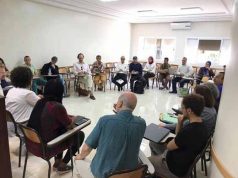Foreward
For numerous Moroccan EFL practitioners in the high school level the teaching of writing is deemed one of the most complicated pedagogical skills to instruct. This is so simply because writing demands successful acquisition of a large number of micro skills. During writing lessons, teachers and pupils alike are aware of the degree of recycling various language components like vocabulary, syntax, semantics, reading, listening, speaking, etc. Henceforth, if pupils are showing symptoms of feeble acquisition of the aforementioned skills, then they will automatically find themselves incompetent to come up with satisfactory writing products. On the plus side, it is not something queer to add that a wide array of EFL practitioners in Morocco do not venture to instruct writing, so as to skip entering into a didactic labyrinth without exit. Accordingly, in pursuit of gaining the power to produce interesting and convincing pieces of writing, Moroccan EFL instructors might retort to a shrewd strategy: the reading to write model.
A general glimpse on the reading to write model
Before the decade of 1980’s reading and writing were dealt as distinct aspects of language literacy. However, around mid 80’s the education arena knew an intense body of researches that appealed for radical transformations. In this sense, the famous contributions of Stotsky (1983) and Krashen (1984) were among the salient works that supported the solid connection and pragmatic finality existing between reading and writing, on the ground that those two acts share analogous cognitive processes of meaning construction. Immediately, in many corners of the world, those two performances started to be instructed as one component of language literacy, known under the term of the reading to write model. Indeed, this cognitive tactic has proved its efficacy and positive result, not solely in junior and high school grade, but even in primary school, college, and university levels.
According to the works of the aforementioned scholars, as well as a contingent of authors whose contributions are mentioned in the references part of this humble essay, reading is not viewed as an isolated language literacy component, but as an integral part of writing. In actuality, the transaction between the two skills forms part of an epistemological circle in which all linguistic skills are intertwined to each other. In this way, the affinity of reading behavior has repercussions over communication and reasoning. That is to say, reading affords student writers with communicating kits together with conceptualizing knowledge that make their lingua and mind to blossom.
Within the school life situation, athlete student readers tend to be better writers than feeble student readers (and the converse is true!). This fact demonstrates that print exposure is significant contributor to the acceleration and lifting of other aspects of verbal intelligence. While incorporating reading to writing classrooms, EFL instructors have more chance to help learners foster their editing techniques, in comparison with other students who are instructed rigid grammar and theoretical composition. Yet, in order to achieve this grade of progression, EFL practitioners are required to elaborate lessons that encompass analytical reading, while students shall embark in autonomous extensive reading.
The two pillars of the reading to write model
1—Analytical reading
It is a sort of text navigation that puts the purposeful student readers in the shoes of the author and which necessitates precise instructions from the part of EFL teachers. Not surprisingly, during the writing process, analytical reading creates a pool of ideas from which student readers borrow many facts, examples, and opinions. On a parallel side, by this sort of perusal reading, student readers become keen about genres, pragmatic discourse, rhetoric devices, along with conventions of writing. In this way, analytical readers who contribute their marks on a text, certainly the text makes its mark on them, through the acquisition of grammatical accuracy and complexity, plus cohesion (the correct organization of ideas) and coherence (the logical links between sentences shaping the paragraph).
In other words, unlike cadaveric reading, analytical reading is an interaction between student readers and text. This interaction prompts student readers with mechanisms to reflect on the knowledge of various texts which they have read and experiences which they have had. Seen in this light, analytical reading generates ideas for writing, during stages of planning, drafting, aligning, revising and monitoring. Now, what is essential is that EFL practitioners are required to expose student readers to a collection of genres, topics, and styles. Here again, one may adduce that in order to write a particular kind of text, it helps if learners have embarked in reading that particular genre of text. On the plus side, EFL teachers do need to create a learning context of true reading spirit that is fueled by discussion and instructional scaffolding and that dispels the phobia of writing. This is achieved only via mining technique, which is in itself a kind of interrogation of the text and that incorporates the coming tips:
- Recognizing content schemata (facts, values) via circling of key concepts, using dictionaries to explain key words, and paraphrasing cardinal ideas;
- Arising specific comprehension questions about the title, author’s voice, genre, cultural features, hand in hand with the visual cues;
- Detecting language schemata (grammar, spelling, punctuation, good word choice, etc);
- Identifying textual schemata (rhetorical structure of various modes of texts);
- Highlighting cohesive devices and their functions, as the case of markers, and logical connectors most appropriate to each of the varied types of texts;
- Picking out instruments of coherency and unity (repetition, parallelism, etc.).
2—Extensive reading
This reading modality needs elongated stretches of time and a high volume of print. The motto which corresponds to extensive reading is: “book eaters are stronger readers”. In terms of genres, topics and styles, reader students must benefit from a choice that fascinates them and that is drown from a field close to students ’interest, in an attempt to match the reading topic to learners’ academic area of specialization. Again, the selected texts should contain non-complicated grammatical pattern, along with vocabulary items and suffixes and prefixes common to their scientific field of studies…
Though it is not per se a purposeful act of reading, on the plea that it suffices with superficial skimming, extensive or aesthetic reading deepens the alumni’s knowledge and enriches their diction reservoir and phonemic awareness, which at the end permits the transfer of knowledge during the moment of composition, in part because student readers use the input storage as a model for text that they will eventually compose, and in other part because this kind of aesthetic reading permits words to come to mind and then to flow from the pen. Here again, this operation is a gradual process that starts with meaningful sentences and ends up with coherent paragraphs- leading of course to accurate essays.
Conclusion
To end this paper, even though reading is a receptive experience and writing is an expressive performance, it is doubly important to acknowledge the close affinity between those dual acts within the language literacy field. Once instructed as one language literacy tool via following the commands of the reading to write model, learners may succeed in producing smart pieces of writing, with fluent language, good structure, and sound opinion. Based on this premise, it comes no surprise that by their proper inquiry student readers arbitrarily discover that learning to write is an artistic discipline, conducted not only in accordance with theory, but with practice and in the presence of a procedure that serves as a source from which to assimilate a sense of the potentialities of the English sentence, together with strategies for organizing meaning, expressing feeling (semantic reservoir) and shaping writing schemata. This is true for once alumni encounter multiple examples, then they certainly will build the “rules and canons” of writing.
Post data:
Conventions of writing or bottom-up issues refer to spelling, punctuation, capitalization, syntax, in addition to text organization (beginning, middle and end), and lexical choices.
References
Anastasio, Cheryl (1979). “Writing through reading.” In: Language and Writing, Volume IV. Connecticut: Yale-New Haven Teachers Institute.
Asención, Y. (2008). “Investigating the reading-to-write construct.” In: Journal of English for Academic Purposes, No 7, pp.140-150. Amsterdam: Elsevier Publishing Solutions.
Carson, J. (1990). “Reading-writing connections: toward a description for second language learners”. In: Second Language Writing: Research Insights for the Classroom, pp. 88-107. New York: Cambridge University Press.
Chuenchaichon, Y. (2011). “Impact of intensive reading on the written performance of Thai university EFL writers. In: Language Studies Working Papers, No 3, pp. 3-14. University of Reading.
English language Guidelines for Secondary Schools: Common Core, First Year & Second Year Baccalaureate (2007). Rabat: Moroccan Ministry of National Education.
Escribano, Pilar Durán (1999). “Teaching writing through reading: a text-centered approach.” In: Ibérica, No 1, pp.55/62. Madrid: European Association of Languages for Specific Purposes.
Kiehl, K. (2013). “Teaching writing through guided reading”. In: http://middleschoolteachertoliteracycoach.blogspot.com/2013/08/teaching-writing-through-guided-reading.html
Krashen, S. (1984). Writing: Research, Theory, and Applications. Oxford: Pergamon.
Langer, J. and Flihan, S. (2000). “Writing and Reading Relationships: Constructive Tasks.” In: Writing: Research/Theory/Practice, edited by: Indrisano Roselmina and Squire James. New York: International Reading Association.
Pennington, Mark (2009). “Twelve tips to teach the reading-writing connection.” In: http://penningtonpublishing.com/blog/reading/twelve-tips-to-teach-the-reading-writing-connection
Rosenblatt, Louise M. (1988). Writing and reading: the transactional theory. Illinois: University of Illinois
Stotsky, S. (1983). “Research on reading/writing relationships: a synthesis and suggested directions.” In: Language Arts, No. 60, pp. 627-642.
Tsai, Jui-Min (2006). “Connecting reading and writing in college EFL courses.” In: The TESL Journal, Vol. XIII, No 12. Columbus: Ohio State University.





